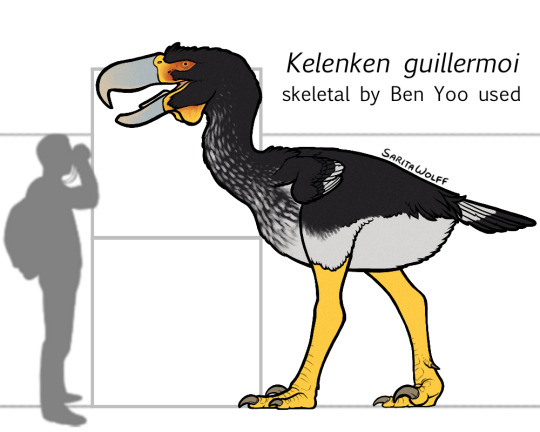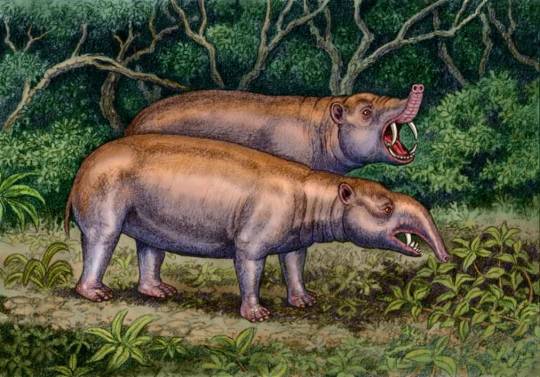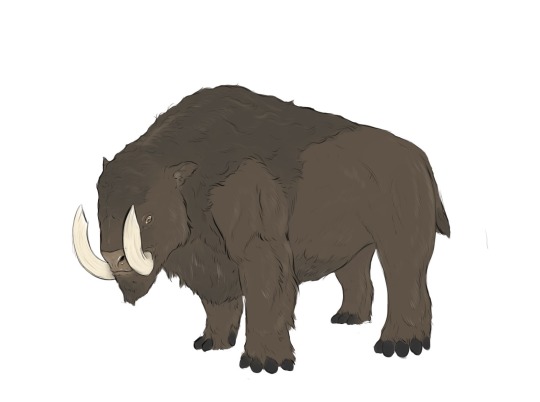#Astrapotherium
Text

Astrapotheres playing in the Pond
5 notes
·
View notes
Text

#fossil#arsinoitherium#astrapotherium#uintatherium#natural history#ancient mammals#Ann Arbor#Michigan#University of Michigan#University of Michigan Museum of Natural History
1 note
·
View note
Text

On the edge of a Miocene South American grassland, a group of Thoatherium is ambushed by a Phorusrhacos. They scatter, but the terror bird catches one of the litopterns, lifts it high up into the air, and SLAMS it down on the ground to kill it. Other nearby animals have mixed feelings about this situation. Tupinambis flees for its life, while Dryornis flies a little closer in case it can have a bit for itself. Hapalops and Astrapotherium are unbothered and have business of their own to take care of.
#phorusrhacos#thoatherium#terror bird#phorusrhacid#litoptern#cariamiform#bird#mammal#santa cruz formation#miocene#neogene#south america#autumn#tupinambis#lizard#squamate#dryornis#new world vulture#accipitriform#hapalops#ground sloth#pilosan#astrapotherium#astrapothere#my art#paleoart#palaeoblr#cw: animal death#cw: blood
77 notes
·
View notes
Text

#Archovember Day 19 - Kelenken guillermoi
The Phorusrhacids, commonly known as “terror birds” were the last dinosaurian apex predators to hunt on land. The largest known phorusrhacid, Kelenken guillermoi, lived in the Middle Miocene of Argentina. It is known only from a skull (though it is one of the most complete large phorusrhacid skulls) and a leg and toe bone, so the rest of its anatomy must be inferred from other phorusrhacids. The skull, the largest of any known bird, is 716 mm (2.3 ft) long, allowing us to estimate Kelenken’s height at around 3 m (9.8 ft) tall. Kelenken would have lived in an open, grassland environment. Its long, slender tarsometatarsus suggests that it was a fast runner, likely adapted for chasing down small animals like rodents, marsupials, and lizards. While large, its skull was relatively weak, so it would have had difficulty gripping onto and subduing large, struggling prey. Instead, it likely preyed on animals it could swallow whole and/or, if targetting larger prey, used repetitive, targeted pecks with its beak. It could have also used its feet to restrain prey. While only Kelenken’s phalanx toe bone has been found, other large phorusrhacids (as well as their living relatives, the seriemas) have a “sickle claw” on their second digits, similar to dromaeosaurs. These claws could have also been used to restrain prey, or to kick out and strike.

Argentina during the Colloncuran age was rife with small critters and did not have a lot of large predators, making Kelenken the likely apex predator. While it probably couldn’t have taken down large adult ungulates like Astrapotherium and Theosodon, it may have been able to hunt typotherians like Hegetotherium, Interatherium, Protypotherium, and Pachyrukhos. Rodents would have been most often on the menu, as cavys were abundent here, as well as lizards and snakes such as Waincophis. Small sparassodonts like Patagosmilus and Cladosictis, would have been both competitors and prey. Only one other dinosaur has been found here so far, the owl Yarquen.
#my art#SaritaDrawsPalaeo#Kelenken guillermoi#Kelenken#terror bird#Phorusrhacids#birds#avialans#theropods#dinosaurs#archosaurs#archosauromorphs#reptiles#Archovember#Archovember2023#saurischians
17 notes
·
View notes
Text

На сайті "Вимерлий світ" нова публікація:
Astrapotherium
Астрапотерії (Astrapotherium) – викопний копитний ссавець родини Астрапотерієві (Astrapotheriidae). Вперше скам’янілості Astrapotherium були знайдені в 1879 році в пластах формації Санта-Крус на півдні Аргентини. На сьогодні відомо кілька знахідок на території Аргентини і Чилі. Датуються олігоценом-міоценом, 29-16 млн. років тому.
Повний текст:
https://extinctworld.in.ua/astrapotherium/
Дякуємо всім за підтримку, для наших патронів на Patreon вже доступний невеликий дарунок (календар для друку).
Підтримуйте нас на Patreon:
https://www.patreon.com/extinctworld
Підписуйтесь на наш телеграм-канал:
https://t.me/extinct_world
Підтримуйте нас на ko-fi:
https://ko-fi.com/extinctworld
#paleontology#extinct animals#paleoart#палеонтологія#палеоарт#prehistoric#вимерлі тварини#astrapotherium#oligocene#miocene#доісторичні істоти#astrapotheriidae#santacruz#argentina#south america#ukraine#made in ukraine#ukraineposts
13 notes
·
View notes
Note
Why is astrapotherium called "lightning beast"?
Just Having A Light Snack Dont Worry About My Champing And Chomping And Go Listen To Jimmey's Buffët It's Summer
247 notes
·
View notes
Text
Meganhinga chilensis

By Ripley Cook
Etymology: The Great Darter
First Described By: Alvarenga, 1995
Classification: Dinosauromorpha, Dinosauriformes, Dracohors, Dinosauria, Saurischia, Eusaurischia, Theropoda, Neotheropoda, Averostra, Tetanurae, Orionides, Avetheropoda, Coelurosauria, Tyrannoraptora, Maniraptoromorpha, Maniraptoriformes, Maniraptora, Pennaraptora, Paraves, Eumaniraptora, Averaptora, Avialae, Euavialae, Avebrevicauda, Pygostaylia, Ornithothoraces, Euornithes, Ornithuromorpha, Ornithurae, Neornithes, Neognathae, Neoaves, Aequorlitornithes, Ardeae, Aequornithes, Suliformes, Anhingidae
Status: Extinct
Time and Place: 17 to 14 million years ago, in the Burdigalian to Langhian ages of the Miocene


Meganhinga is known from the Malla-Mall Member of the Cura-Mallín Formation

Physical Description: Meganhinga was, in a lot of ways, essentially just a scaled-up version of the birds we know today as Darters - it had a long body, with a very long neck, small head, and long pointy beak. This was similar in every way to living Darters. It was quite long for a darter, about a meter long, which is about as big as they get today (but usually living Darters are much smaller). But, notably for Darters, it had quite small wings indeed. This means that Meganhinga was, above all, a flightless bird.
Diet: Meganhinga probably fed on fish and other vertebrates, like its living relatives; its uncertain if it was able to dive as well as its living relatives, so its possible it relied more on land life than its living relatives.
Behavior: Meganhinga, being flightless, probably would have spent more of its time on land grabbing food than living relatives. Still, despite this, it would have spent much of its time by the shoreline, diving into the water and searching for food. Its long neck could be darted out to grab food, including fish, as it would stand on the shoreline. It would probably breed in colonies, and it seems most likely that they would have been somewhat monogamous in breeding habits like living Darters.
Ecosystem: Meganhinga lived in a lake and river basin near the coast, filled with plenty of aquatic places for Meganhinga to find food. This freshwater basin was created by extensive volcanic activity, which would have decided affected the ecology and creatures living there. Many different kinds of animals resided here with Meganhinga, though most were mammals; creatures such as Toxodonts, Astrapotherium, marsupials like Polydolops, the fascinating Mylodontid sloth Nematherium, a glyptodont, Protypotherium, a wide variety of rodents, and other creatures all populated the valley. Despite this, there doesn’t really seem to be another bird from this formation known at this time.
Other: Meganhinga is quite distinctive for being, possibly, the oldest known species of Darter, which makes the fact that it is quite weird compared to living darters very noticeable. In fact, a variety of large, flightless Darters from the Miocene have been found - Meganhinga, Macranhinga, and Giganhinga - all from the are of Chile in the Miocene. This indicates flightlessness was a major lifemode for Darters prior to modern times. Interestingly enough, some phylogenies indicate modern darters evolved from these forms, meaning that these flightless birds re-evolved flying ability in response to environmental factors.
~ By Meig Dickson
Sources under the Cut
Alvarenga, H. F. 1995. A large and probably flightless Anhinga from the Miocene of Chile. Courier Forschungsinstitut Senckenberg 181: 149-161.
Areta, J. I., J. I. Noriega, D. Angolin, F. Angolin. 2007. A giant darter (Pelecaniformes: Anhingidae) from the Upper Miocene of Argentina and weight calculation of fossil Anhingidae. N. Jb. Geol. Palaont. Abh. 243 (3): 343 - 350.
Chavez, M. 2007. Fossil birds of Chile and Antarctic Peninsula. Arquivos do Museo Nacional, Rio de Janeiro 65(4):551-572
Croft, D. A., J. P. Radic, E. Zurita, R. Charrier, J. J. Flynn, A. R. Wyss. 2003. A Miocene toxodontid (Mammalia: Notoungulata) from the sedimentary series of the Cura-Mallín Formation, Lonquimay, Chile. Revista geológica de Chile 30 (2): 285 - 298.
Croft, D. A., R. Charrier, J. J. Flynn, A. R. Wyss. 2008. Recent additions to knowledge of Tertiary mammals from the Chilean Andes. Simposio Paleontología en Chile 1: 91 - 96.
Flynn, J. J., R. Charrier, D. A. Croft, P. B. Gans, T. M. Herriott, J. A. Wertheim, A. R. Wyss. 2008. Chronologic implications of new Miocene mammals from the Cura-Mallín and Trapa Trapa formations, Laguna del Laja area, south central Chile. Journal of South American Earth Sciences 26 (4): 412 - 423.
Mayr, G. 2017. Avian Evolution: The Fossil Record of Birds and its Paleobiological Significance. Topics in Paleobiology, Wiley Blackwell. West Sussex.
Pedroza, V., J. P. Le Roux, N. M. Guitérrez, V. E. Vicencio. 2017. Stratigraphy, sedimentology, and geothermal reservoir potential of the volcaniclastic Cura-Mallín succession at Lonquimay, Chile. Journal of South American Earth Sciences 77: 1 - 20.
Rubilar, A. 1994. Diversidad ictiologica en depositos continentales miocenos de la Formacion Cura-Mallin, Chile (37-39°S): implicancias paleogeograficas. Revista Geológica de Chile 21 (1): 23- 29.
Suárez, M., C. Emparan. 1995. The stratigraphy, geochronology and paleophysiography of a Miocene fresh-water interarc basin, southern Chile. Journal of South American Earth Sciences 8 (1): 17 - 31.
#Meganhinga#Meganhinga chilensis#Darter#Dinosaur#Bird#Birds#Prehistoric Life#Palaeoblr#Birblr#Dinosaurs#Ardeaen#Prehistory#Paleontology#Aequorlitornithian#Terrestrial Tuesday#Piscivore#South America#Neogene
94 notes
·
View notes
Text

Opossum Wolf

Wholly Tuskodon

Greater Lightning Beast, Astrapotherium magnum
0 notes
Photo

Astrapotherium magnum, a relative of the elephant. Art by Sergey Krasovskiy (✎ by redditor ImHalfCentaur1) Discover more wonders of the #cosmos at https://discover.earth #wildlifephotography #wild #wildlife_perfection #animals #safari #wildlife_seekers #africa #animal #conservation #wildlifeplanet #animalsofinstagram #animallovers #africanamazing #natgeowild #wildlifeaddicts #igscwildlife #animalelite #vertebrate #terrestrial #animal #wildlife #snout #organism #rhinoceros #zoo #dinosaur
0 notes
